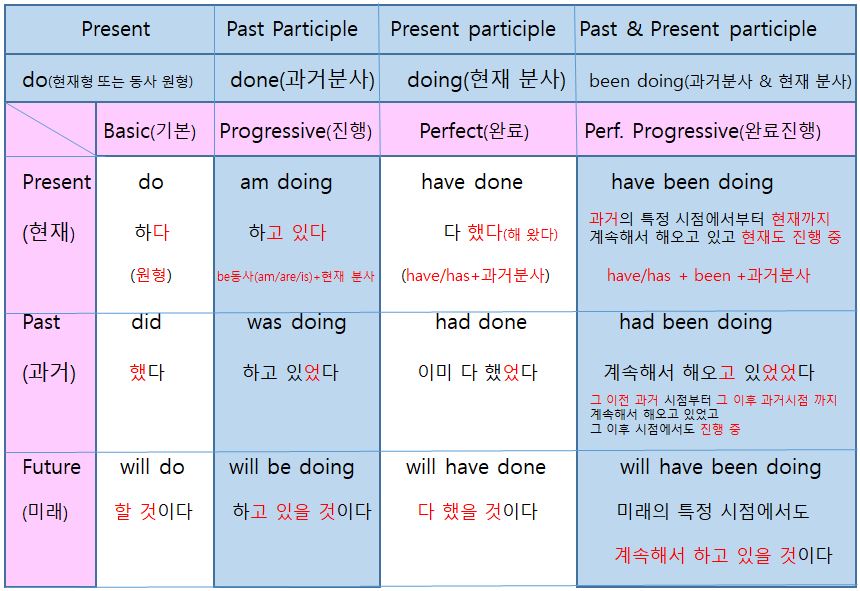Learning the Korean "Tense" the easiest and quickest way
가장 쉽고, 빠르게 한국어 "시제(Tense)"를 배우는 법
In all languages, it is important to distinguish the tense in which the conversation is taking place. However, based on the characteristics of each language, there may or may not be a clear verb tense or words that signify time.
모든 언어에는 서로 대화할 때 ‘대화 내용의 시점’을 구분하는 것은 모두 동일합니다. 다만 각각의 언어의 특성에 따라서 그 시점을 구분하는 ‘단어의 형태’가 있느냐, 없느냐의 차이입니다.
For example, there are a total of 26 consonants and vowels in English, but there are 14 basic consonants and 10 basic vowels in Korean, a total of 24. However, the double vowels and double consonants of the unique Korean word system add up to a total of 40.
예를 들면, 영어에는 총 26개의 자음과 모음이 있지만, 한국어에는 기본 자음 14개, 기본 모음 10개로 총 24개입니다. 그러나 한국어 소리 구조의 특성상 이중 모음과, 쌍자음을 더하면 총 40개입니다.
English is composed of 26 consonants and vowels. They are not pronunciation notation.
영어는 26개의 자음과 모음으로 구성되어 있습니다. 발음표기법이 아닙니다.
Consonants: B,C,D,F,G,H,J,K,L,M,N,Q,P,R,D,T,V,W,X,Y,Z
Vowels: A,E,I,O,U
24 basic consonants and vowels in Korean are as follows.
한국어 기본 자음과 모음 24개는 다음과 같습니다.
Consonants: ㄱ,ㄴ,ㄷ,ㄹ,ㅁ,ㅂ,ㅅ,ㅇ,ㅈ,ㅊ,ㅋ,ㅌ,ㅍ,ㅎ = 총 14개
Vowels: ㅏ, ㅑ, ㅓ, ㅕ, ㅗ, ㅛ, ㅜ, ㅠ, ㅡ, ㅣ= 총 10개
There are 40 including double consonants and double vowels, as shown below.
쌍자음과 이중모음을 포함하면 40개이며, 아래와 같습니다.
Consonant and double consonant:
ㄱ,ㄴ,ㄷ,ㄹ,ㅁ,ㅂ,ㅅ,ㅇ,ㅈ,ㅊ,ㅋ,ㅌ,ㅍ,ㅎ,ㄲ,ㄸ,ㅃ,ㅆ,ㅉ=총 19개
Short vowels-단모음: ㅣ, ㅔ, ㅐ, ㅏ, ㅜ, ㅗ, ㅓ, ㅡ, ㅟ, ㅚ (단모음 10개)
Double vowel-이중모음:ㅑ, ㅕ, ㅛ, ㅠ, ㅒ, ㅖ, ㅘ, ㅝ, ㅙ, ㅞ, ㅢ' (이중모음 11개)
In other words, even if you want to express the same thing, English uses 26 alphabets while Korean uses 40 alphabets. In order to convey the same meaning in both languages, you may need to use a suffix or idiom instead of direct substitution of verb tenses (which will be shown in the examples down below).
다시 말해서 동일한 의사 표현을 하더라도 영어는 26개의 알파벳을 사용하지만, 한국어는 40개의 알파벳을 사용하는 것입니다. 각각의 언어에 시제를 표현하고자 하는 표현은 동일하지만 그 시제를 표현할 수단인 단어의 형태가 존재하거나 아니면 다른 접미사나 관용구를 대신 사용할 수도 있다는 점이다.
Therefore, while there are 12 verb tenses in English, the Korean language is based on the 6 tenses. However, using the six tenses as well as the suffixes(which will be shown in the example), you can convey the 12 verb tenses as you do in English.
따라서 영어는 12시제 구분이 단어의 형태로 명확하지만, 한국어에는 기본 6시제를 바탕으로 ‘조사’와 ‘종결 어미’들을 사용해서 영어 12시제와 동일한 표현을 사용하고 있습니다.


The twelve tenses in Korean are as follows
한국어의 12시제는 다음과 같다
- Basic tense(기본 시제)
Present(현재)
Past(과거)
Future(미래)
- Progressive tense(진행형 시제)
Present progressive(현재 진행형)
Past progressive(과거 진행형)
Future progressive(미래 진행형)
In addition, the tenses that can be expressed using 'suffix' and 'final suffix'.
추가로 ‘조사’와 ‘종결 어미’들을 사용해서 표현 가능 시제
- Perfect tense(완료시제)
Present perfect(현재완료)
Past perfect(과거완료)
Future perfect(미래완료)
- Perfect Progressive(완료 진행형)
Present perfect progressive(현재완료 진행형)
Past perfect progressive(과거완료 진행형)
Future perfect progressive(미래완료 진행형)

I will explain the Korean tense above by comparing it with English.
위 한국어 시제를 영어와 비교해서 설명을 해 보겠습니다.

The next step is to find out how the twelve tenses of Korean and English are used in real sentences. The Korean and English words that represent the same tense are indicated via their color. Same colour words mean they are the same tense.
다음 순서로는 실제 문장에서 어떻게 한국어와 영어의 12 시제가 정말로 사용되는지 알아보겠습니다. 한국어와 영어 단어의 글씨는 색깔별로 동일한 시제를 나타낸다.


So far, I have explained about the Korean tense. I tried to explain it as easy and simple as possible for foreigners to learn Korean. I hope it'll help you a lot.
지금까지 한국어 시제에 대해서 설명했습니다. 외국인이 한국어를 배우는 기준으로 최대한 쉽고 단순하게 설명하도록 노력했습니다. 여러분에게 많은 도움이 되길 바랍니다.